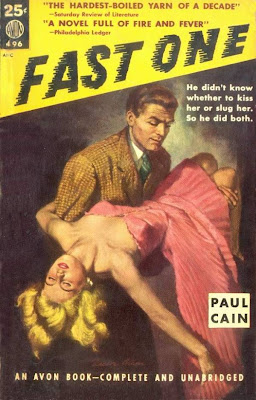In honor of "The Tasting Machine," coming as Friday's Forgotten Story, here's a repeat presentation of my review of Fast One.
When I first read this, sometime around 1980, it probably qualified as a forgotten book. Heck, I was even able to afford a first edition. These days it’s more of a legendary book. It's been reprinted several times, lionized, and even adapted as a graphic novel. As of Feb. 2010, when this review was written, a guy on Abe wanted $2250 for a first in a crappy dust jacket, and another was asking $750 for a copy without. Yikes.
Fast One is not a whodunnit. It’s a who’s gonna get it next, and from whom. The biggest mystery may be who (if anyone) will still be alive at the end.
Fast One has been acclaimed for its razor-sharp prose and bullet-like speed. I can’t argue with that. It’s tough, fast and to the point, probably more than any book that had come before.
I was talking to a friend about this recently and he said he didn’t particularly enjoy it. The book was all plot, he said, and almost no character development. Well, I see his point. The story appeared in Black Mask in 1932 as five separate novelettes (a sample of the last segment, called "The Dark", is featured below) . Since each piece had to stand on its own, the book has five plots, each with its own rising conflict and semi-resolution. Each story builds on those before, so things get pretty complicated. Everytime you turn a page, someone new is walking in with a gun.
As for the characters --- it’s hard to imagine a more venal bunch of amoral backstabbers assembled in a single novel. Almost without exception, they are out solely for themselves, willing to betray allies and switch allegiances at the drop of a plot point. Imagine throwing a bunch of dirty cops, dirty politicians and just naturally dirty mobsters into a barrel and clamping on a lid. Then tumble the barrel down a hill before prying off the lid to see who claws their way out.
Our anti-hero Gerry Kells arrives in L.A. from the East, where the cops considered him the “it” guy everytiime there was a shooting. Now out West, he just wants to be left alone to gamble and enjoy himself. Trouble is, everyone wants him on their side - and if they can’t have him they want him dead. He’s too dangerous a guy to be walking around loose.
As for character development, there actually is some, but you have to look real close. Though Kells would never admit it, his actions show he develops feelings for a couple of his more steadfast allies. In the end, he places loyalty and - perhaps - love, above his own self interest. The question is, will these uncharacteristically human qualities redeem him or destroy him? Read it and see.
Researchers have peeled back the layers of Paul Cain to find he was actually George Sims, who also wrote screenplays as Peter Ruric. One of his first screen credits (for story, not screenplay) was for Gambling Ship, a film very loosely based on Fast One. I’m told his screenplay for the Karloff film The Black Cat is especially good. I’ll be checking it out.
In addition to Fast One, Cain had a dozen stories in Black Mask and two in other detective mags. Seven of those appear in the collection Seven Slayers and a couple others, "Trouble-Chaser" and "Sockdolager," have been reprinted elsewhere. Three of the remaining five, "Dutch Treat," "Chinaman's Chance" and "555," are yours for the asking at delewis1@hotmail.com. As for the last two, "Hunch" and "Death Song," watch this space next week for really BIG NEWS!






No comments:
Post a Comment